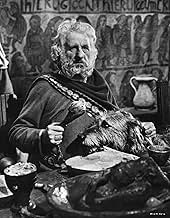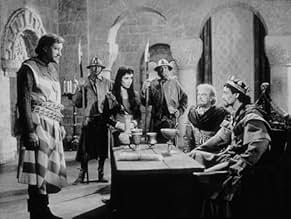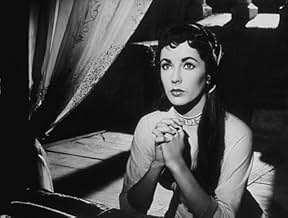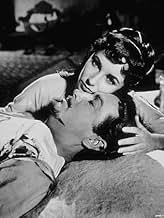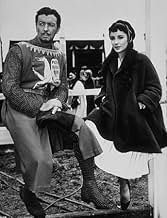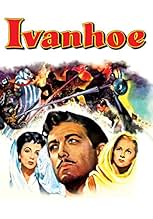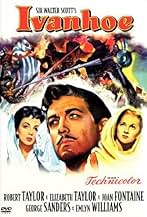VALUTAZIONE IMDb
6,7/10
10.882
LA TUA VALUTAZIONE
Un cavaliere cerca di liberare il prigioniero Re Riccardo e rimetterlo sul trono.Un cavaliere cerca di liberare il prigioniero Re Riccardo e rimetterlo sul trono.Un cavaliere cerca di liberare il prigioniero Re Riccardo e rimetterlo sul trono.
- Regia
- Sceneggiatura
- Star
- Candidato a 3 Oscar
- 2 vittorie e 9 candidature totali
Francis De Wolff
- Front De Boeuf
- (as Francis DeWolff)
Recensioni in evidenza
This splendid version of Sir Walter Scott's classic epic tale starts in 12th century, when Saxon Knight Wilfred of Ivanhoe(Robert Taylor), a suitable noble, having fought for Richard the Lionhearted(Norman Wooland) during the Crusades, goes back to England. He aware king Richard has been taken prisoner and gets a letter written, telling the following : 'To the people of England . I am here held captive by Leopold of Austria. My brother, prince John has knowledge of it, yet he has denied my ransom. One hundred and fifty thousand marks of silver. I fear he does conspire with certain Norman knights to seize my throne. People of England, speed my deliverance. Your kingdom is at stake'. In order to regain his freedom, Ivanhoe attended by a likable squire(Emilyn Williams) confronts Prince John(Guy Rolfe) and his lieutenants(in this case George Sanders and Robert Douglas)and he's also drawn to Jewish healer Rebecca(Elizabeth Taylor), Isaac(Felix Aylmer)of York's daughter. Meanwhile, Ivanhoe woo maidens, as his childhood sweetheart, Saxon heiress Rowena(Joan Fontaine).Prince John, now John Lackland will stop at nothing to assume the throne. Ivanhoe join forces with Robin Hood and his Merry man who attack the stronghold.
This enjoyable film displays romance, chivalry, knighthood, daring jousting and lots of action with spectacular castle attack. This one proved notable hit as well as the others two Robert Taylor's forays into English history, 'Quentin Durward and Knights of the Round table', produced and directed by similar crew, Pandro S Berman and Richard Thorpe. The film packs a glamorous and luminous cinematography by Freddie Young and evocative musical score by Miklos Rozsa. The picture is excellently handled by Richard Thorpe.
The film is partially based on true events. Although Ivanhoe didn't exist, John Lackland was king of England from 1199 to 1216. Few monarchs have been subject to such appalling publicity as John, Although by no means lovable, he was an able administrator and spent more time in England than his predecessor and elder brother Richard I but he was jailed by Leopold of Austria, returning from Crusades. Besides appears Robin Hood, also known Robin O'Locksley and the Earl of Huntingdom, is probably and sadly a creation of romantic imaginations. If Robin Hood did exist, it's almost certain that he was not a Saxon , though his enemies may well have been the Norman sheriff of Nottinghan and Prince and later king John Lackland.
This enjoyable film displays romance, chivalry, knighthood, daring jousting and lots of action with spectacular castle attack. This one proved notable hit as well as the others two Robert Taylor's forays into English history, 'Quentin Durward and Knights of the Round table', produced and directed by similar crew, Pandro S Berman and Richard Thorpe. The film packs a glamorous and luminous cinematography by Freddie Young and evocative musical score by Miklos Rozsa. The picture is excellently handled by Richard Thorpe.
The film is partially based on true events. Although Ivanhoe didn't exist, John Lackland was king of England from 1199 to 1216. Few monarchs have been subject to such appalling publicity as John, Although by no means lovable, he was an able administrator and spent more time in England than his predecessor and elder brother Richard I but he was jailed by Leopold of Austria, returning from Crusades. Besides appears Robin Hood, also known Robin O'Locksley and the Earl of Huntingdom, is probably and sadly a creation of romantic imaginations. If Robin Hood did exist, it's almost certain that he was not a Saxon , though his enemies may well have been the Norman sheriff of Nottinghan and Prince and later king John Lackland.
An engrossing movie about 12th century England. It has everything you would want to see in a movie about medieval Europe: knights, fair maidens, jousting tournaments, battles, and feuding crowns. Yet the movie is not boring in any way. I enjoyed every minute of it. The title character is an Anglo-Saxon knight who's on a mission to return the imprisoned king, Richard the Lionhearted, to his throne. Along the way, Ivanhoe encounters some obstacles that may endanger his own life and threaten the future of England. Everything about this movie is enchanting. The movie is very colorful, the score is outstanding, and it's exciting to watch the battle scenes. I really enjoyed seeing one of my favorite actors, George Sanders, playing yet another villain. It was also great to see the always ravishing Elizabeth Taylor (at a very young age), who plays a jewish maiden. I liked the way the movie demonstrated the persecution of jews living in England at the time, and how they were looked down upon in spite of the different ethnic groups that made up the English population. Above all, I really liked the ending--it was awesome. Interestingly, this movie (which is from 1952) is more entertaining than and not as theatrical as some of the historical dramas that were made AFTER this movie.
I can't comment on the film as an adaption but I did find that it was quite entertaining standing alone. Some have criticized Robert Taylor for being too stiff, but I found him to be suitably formal and chivalrous. Elizabeth Taylor and Joan Fontaine both provided ample glamour and grace to their roles. They are also both very photogenic to say the least. The performance of George Sanders intrigued me the most. Though a villain, he actually became more sympathetic to me as the movie progressed. The relationship of the four major characters was what kept me interested. Although I am sure it took careful planning and execution (and a lot of extras) to stage the fight scenes, I actually thought they were quite perfunctory. Solid if not spectacular, 7/10.
I love this film, especially the jousting tournament scene. I think one of the reasons why it touched me so deeply because the tournament scene was based on 'The Tournament of the Black Lady' held by King James lV of Scotland in 1507 at Edinburgh Castle. He competed against five knights (whom he defeated) and presented himself in black armour to conceal his identity. His Queen of Love and Beauty was his African attendant, Ellen, whom he dedicated to the tournament to. Sir Walter Scott would have had this fresh in his mind when he was re-writing the Robin Hood story.
The difficulty with bringing a piece of revered literature to the big screen has more to do with pleasing the fans of the work than in making a pleasing movie. Those who hold Walter Scott's classic "Ivanhoe" in high esteem will deem any adaptation to a largely visual medium unworthy no matter how much care and devotion are given to visualizing the original source.
This version of "Ivanhoe" holds up well and remains one of the more realistic films dealing with the myth, legends, and pomp of the High Middle Ages. The pictorial representation of Judaism at a time of wide-spread persecution of that religion throughout Europe by Christians who continually used the Jews as scapegoats was noble indeed for 1952, the height of the McCarthy witch hunts. The audience of the day undoubtedly overlooked this point when Rebecca is accused of witchcraft in order to insure conformity and stifle opposition to Prince John's tyrannical rule of England in King Richard's absence.
From a historical perspective, this film is about as accurate as any of the numerous Robin Hood tales prevalent at the time in the movies and on TV. Ivanhoe's father is correct when he remarks that Richard would be no better than John as far as the Saxons were concerned. Both Richard and John were ineffectual rulers. Prince John (later King John) has received a bad press as a result of the lionization of Richard the Lionheart. At least John stayed home and attempted to rule England; whereas, Richard was always traipsing about Europe and the Near East on a Crusade or leading his knights in battle mainly for personal gain. His ransom as a result of falling into the hands of the Germans was costly for his realm. Neither Richard or John was the skilled administrator their father, Henry II, proved to be, one of England's greatest monarchs. Neither inherited the diplomatic skills of their mother, Eleanor of Aquitaine, one of the great women leaders in western civilization.
The division between the Saxons and Normans as a result of the Norman invasion of 1066 is at the crux of the story, Ivanhoe being Saxon, the royal family being Norman, descended from William the Conqueror. Nothing is said about those who lived on the British Isles before either the Saxons or the Normans, the Celts first, then the conquering Romans.
A highlight of "Ivanhoe" is the jousting tournament, leading to rivalry between Ivanhoe (Robert Taylor) and Sir Brian de Bois-Guilbert (George Sanders), a rivalry that extends to winning the hand and heart of Rebecca. The alluring nineteen-year-old Elizabeth Taylor who portrays Rebecca is at the peak of her beauty and loveliness. George Sanders and Robert Taylor were much older than Elizabeth at the time. Taylor was uncomfortable making love, even on celluloid, to one so young, especially since he recalled her as a child in the early days of his movie career.
The brilliant Technicolor cinematography is bewitching even by today's standards. Adding to the eye-catching color are the action scenes, especially toward the end of the movie. The besieging of the castle is directed with élan by Richard Thorpe, who learned his trade well from directing action packed B films.
The acting is top notch throughout with Guy Rolfe as the loathsome Prince John stealing every scene he's in. The weakest is Emlyn Williams who plays Wamba (a chattel who becomes Ivanhoe's Squire). Wamba apparently is supposed to supply comic relief and is given some good lines by the writers, but Williams tends to overplay the part to the extent that at times the character becomes an obnoxious loudmouth.
This version of "Ivanhoe" holds up well and remains one of the more realistic films dealing with the myth, legends, and pomp of the High Middle Ages. The pictorial representation of Judaism at a time of wide-spread persecution of that religion throughout Europe by Christians who continually used the Jews as scapegoats was noble indeed for 1952, the height of the McCarthy witch hunts. The audience of the day undoubtedly overlooked this point when Rebecca is accused of witchcraft in order to insure conformity and stifle opposition to Prince John's tyrannical rule of England in King Richard's absence.
From a historical perspective, this film is about as accurate as any of the numerous Robin Hood tales prevalent at the time in the movies and on TV. Ivanhoe's father is correct when he remarks that Richard would be no better than John as far as the Saxons were concerned. Both Richard and John were ineffectual rulers. Prince John (later King John) has received a bad press as a result of the lionization of Richard the Lionheart. At least John stayed home and attempted to rule England; whereas, Richard was always traipsing about Europe and the Near East on a Crusade or leading his knights in battle mainly for personal gain. His ransom as a result of falling into the hands of the Germans was costly for his realm. Neither Richard or John was the skilled administrator their father, Henry II, proved to be, one of England's greatest monarchs. Neither inherited the diplomatic skills of their mother, Eleanor of Aquitaine, one of the great women leaders in western civilization.
The division between the Saxons and Normans as a result of the Norman invasion of 1066 is at the crux of the story, Ivanhoe being Saxon, the royal family being Norman, descended from William the Conqueror. Nothing is said about those who lived on the British Isles before either the Saxons or the Normans, the Celts first, then the conquering Romans.
A highlight of "Ivanhoe" is the jousting tournament, leading to rivalry between Ivanhoe (Robert Taylor) and Sir Brian de Bois-Guilbert (George Sanders), a rivalry that extends to winning the hand and heart of Rebecca. The alluring nineteen-year-old Elizabeth Taylor who portrays Rebecca is at the peak of her beauty and loveliness. George Sanders and Robert Taylor were much older than Elizabeth at the time. Taylor was uncomfortable making love, even on celluloid, to one so young, especially since he recalled her as a child in the early days of his movie career.
The brilliant Technicolor cinematography is bewitching even by today's standards. Adding to the eye-catching color are the action scenes, especially toward the end of the movie. The besieging of the castle is directed with élan by Richard Thorpe, who learned his trade well from directing action packed B films.
The acting is top notch throughout with Guy Rolfe as the loathsome Prince John stealing every scene he's in. The weakest is Emlyn Williams who plays Wamba (a chattel who becomes Ivanhoe's Squire). Wamba apparently is supposed to supply comic relief and is given some good lines by the writers, but Williams tends to overplay the part to the extent that at times the character becomes an obnoxious loudmouth.
Lo sapevi?
- QuizAt the beginning, Sir Wilfred of Ivanhoe is looking for King Richard I by singing until he finds the King. This is historically accurate, with the exception that the singer was a minstrel called Blondel. When Leopold of Austria captured King Richard I, Blondel went around to all of the castles singing King Richard's favorite song. (One story had it that King Richard actually co-wrote the song.) When he heard King Richard join in the chorus, he went home and told the Normans where King Richard was.
- BlooperCharacters are shown eating turkey during the feast in Ivanhoe's father's hall. Turkeys are indigenous to North America and were not known in England in the 12th century.
- Citazioni
Minor Role: Milord, there is a stranger at your gate who begs shelter. He is a Jew who calls himself Isaac of York.
Sir Brian de Bois-Guilbert: I share no roof with an infidel.
Wamba: Why not, sir knight? For every Jew you show me who's not a Christian, l'll show you a Christian who's not a Christian.
- ConnessioniEdited into Hollywood: The Dream Factory (1972)
- Colonne sonoreThe Song of Ivanhoe
(1952) (uncredited)
Music by Miklós Rózsa
Lyrics by Marguerite Roberts
Sung by Robert Taylor and Norman Wooland
I più visti
Accedi per valutare e creare un elenco di titoli salvati per ottenere consigli personalizzati
- How long is Ivanhoe?Powered by Alexa
Dettagli
- Data di uscita
- Paesi di origine
- Lingua
- Celebre anche come
- Sir Walter Scott's Ivanhoe
- Luoghi delle riprese
- MGM British Studios, Borehamwood, Hertfordshire, Inghilterra, Regno Unito(studio: interiors and exteriors: Torquilstone Castle and lists at Ashby La Zouche)
- Azienda produttrice
- Vedi altri crediti dell’azienda su IMDbPro
Botteghino
- Budget
- 3.842.000 USD (previsto)
- Tempo di esecuzione
- 1h 46min(106 min)
- Proporzioni
- 1.37 : 1
Contribuisci a questa pagina
Suggerisci una modifica o aggiungi i contenuti mancanti


